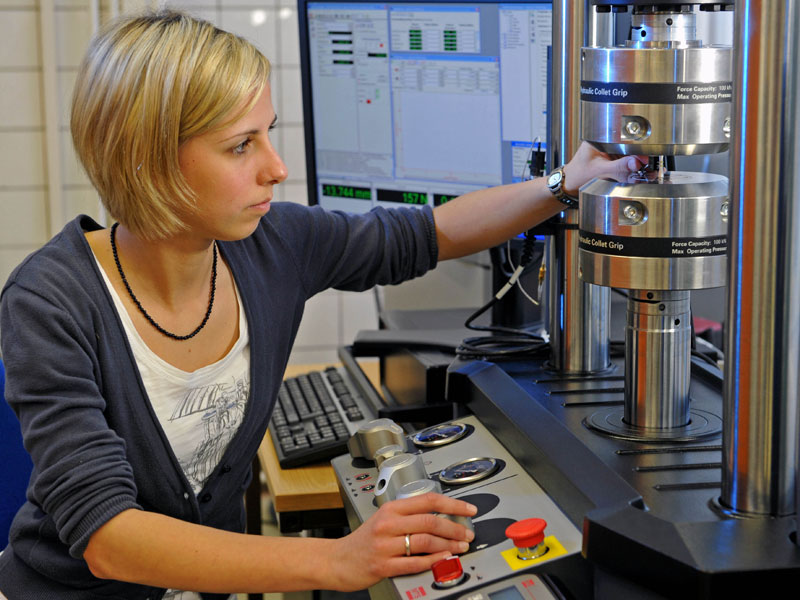Making materials lighter and stronger
Fundamental research with relevance for society: The Collaborative Research Centre "High-strength aluminum-based lightweight materials for safety components" receives funding for another four years
-

The Institute of Materials Science and Engineering’s Dr. Kristin Hockauf uses a servo hydraulic fatigue testing machine to study an ultra fine grained aluminum alloy as part of her research in the Collaborative Research Center HALS. Picture: Archive Press Office/Hendrik Schmidt
At their Autumn Meeting on 21st of November in Bonn, representatives of the German Research Foundation (Deutsche Forschungsgemeinschaft, DFG) have decided to continue funding of the Collaborative Research Centre 692 "High-strength aluminum-based lightweight materials for safety components" (HALS) at the Technische Universität Chemnitz. Research in HALS thus enters its third and final funding period.
"This is a very enjoyable and motivating for the TU Chemnitz as host institution and for the participating Faculties of Mechanical Engineering and Economics and Business Administration, as well as for the Fraunhofer Institute for Machine Tools in Chemnitz", appreciates Prof. Dr. Arnold van Zyl, Rector of the TU Chemnitz. Knowledge from the fields of materials science and engineering, forming, manufacturing and surface engineering, mechanics, design and manufacturing technology and economics come together and contribute to the central goals of the interdisciplinary research project. "Clearly, in the past eight years the scientists of the Collaborative Research Centre have performed excellent research with high social relevance and could therefore convince the DFG reviewers. During the next four years, the Collaborative Research Centre will continue to provide important input for two of the three focus areas of our university - namely Energy Efficient Production Processes and Smart Systems and Materials". The funding by the DFG supports the TU Chemnitz in continuously providing excellent funding conditions and career opportunities for young scientists in this research area.
In the past eight years, scientists of the Collaborative Research Centre have achieved several noteworthy successes, such as the formation and investigation of ultra fine-grained microstructures in light metals and their alloys by severe plastic deformation. These materials are characterized by particularly interesting mechanical properties, like high strength and good ductility. Considering Germany´s "Energiewende” (energy transition) and similar mega topics, these materials may prove to be of great practical importance. The basic research performed in Chemnitz attracted an increasing interest among experts, for example in materials science. In the Collaborative Research Centre, one of the world´s largest tools for forming by equal channel angular pressing has been developed. Moreover, entirely new forming processes that produce graded ultra-fine grained microstructures and thus enable improved mechanical properties in near-surface regions of semi-finished products were developed in cooperation with the Chemnitz Fraunhofer Institute for Machine Tools (IWU), one of the most important research and development facilities in the field of manufacturing technology. The Collaborative Research Centre has also benefited increasingly from progress in the mechanical modeling and numerical simulation. This research area is expected to further provide important contributions in the third funding period.
The central aim of the Collaborative Research Centre in the next four years will be to tap the full potential of high-strength aluminum-based lightweight materials for the manufacture of safety components. In addition, the research results for example in the area of severe plastic deformation will be used in transfer projects, where applied research together with industrial companies will focus on manufacturing semi-finished products. "The reviewers of the DFG were particularly impressed by this two-fold strategy with strong projects both in fundamental materials science research as well as in applied engineering science", says Prof. Dr. Martin Wagner, the future speaker of the Collaborative Research Centre, who coordinated the planning for the third period. With the retirement of the center´s current speaker, Prof. Dr. Bernhard Wielage, Wagner will lead one of the largest research projects of the TU Chemnitz. "We are very proud of this success, which was only possible through a joint effort of the whole Collaborative Research Center team. During the next four years, we will now be able to reap the fruits of our labor, and we will focus strongly on bringing our research to the attention of the international scientific community”. "As the leading institute for resource-efficient production, the Fraunhofer IWU contributes its extensive expertise in research and development in the field of production technology for the automotive and mechanical engineering industries to this special field of research", says the Acting Director of the Institute, Dr. Welf-Guntram Drossel, and adds: "With the opening of the new E3-Research Factory `Resource-efficient Production´ in early 2014, new concepts can be developed and tested that are related to the topics of energy and resource conservation. The results of the Collaborative Research Centre will be a basis for these projects as well."
"The continued funding for these Collaborative Research Centres shows once again the great potential of the universities in the Free State of Saxony ", says Saxony´s Science Minister Prof. Dr. Sabine von Schorlemer, emphasizing the recent success of two Collaborative Research Centres in the Free State of Saxony. Collaborative Research Centres are an important part of the Saxon research. "This research is focused on fundamental key research areas, and forms the basis for future innovations", says the Minister. "The cooperation between our university and Fraunhofer, which provides an important basis for applied research, is of particular importance”, adds Prof. van Zyl.
Topic: Collaborative Research Centres funded by the DFG
Collaborative Research Centres provide funding for the realization of complex research projects at universities. They are subject to regular reviews. For a period of up to twelve years, scientists from different disciplines can focus on interdisciplinary work on a genuine research topic. Collaborative Research Centres also particular aim at supporting young talents and the profiling of the involved universities and research institutes.
On the 1st of October 2013, the DFG funded a total of 232 Collaborative Research Centres. For this purpose the corresponding budget, in 2013, consisted of approximately 588 million euros. This corresponds to a share of about 22 per cent of the total budget of the DFG. There are 171 classic Collaborative Research Centres (based exclusively at one host university) and 61 SFB/Transregio, where a research network is shared by up to three universities. The 232 Collaborative Research Centres are located at 57 host universities. Scientists at the Technische Universität Chemnitz are currently involved in one Collaborative Research Centre and in two SFB/Transregio Centers.
For more information on the Collaborative Research Centre "High-strength aluminum-based lightweight materials for safety components", please contact Prof. Dr. Martin Wagner, phone 0049 371 531-38683, e-mail: martin.wagner@mb.tu-chemnitz.de.
(Author: Mario Steinebach, Translation Jakob Landwehr)
Mario Steinebach
29.11.2013




